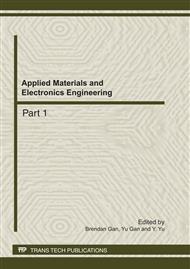[1]
J. D. Carlson, D. M. Catanzatite and K. A. St. Clare. Commerical magnetorheological devices[J]. Proceedings of the 5th International Conference on ER Fluids, MR Suspensions and Their Applications, pp.20-28, (1996).
Google Scholar
[2]
M.R. Jolly, J.W. Bener and J. D. Carlson. Properties and applications of commercial MR fluids[J]. Journal of Intelligent Material Systems and Structures, pp.5-13, (1999).
Google Scholar
[3]
Wang, X. and Gordaninejad, F. Flow Analysis of Field-Controllable, Electro- and Magneto-Rheological Fluids Using Herschel-Bulkley Model [J]. Journal of Intelligent Materials, System and Structures, Vol 10, No. 8, Pp. 601-608, (1999).
DOI: 10.1106/p4fl-l1el-yflj-btre
Google Scholar
[4]
Pialet J W, Clark D R. Progress in electrorheology[M]. New York: Plenum Press, (1995).
Google Scholar
[5]
D. R. Gamota and F. E. Filisko. Dynamic mechanical studies of electroheological matreials: Moderate frequencies[J]. J. Rheol 35(3), April (1991).
Google Scholar
[6]
Philips R W. Engineering applications of fluids with a variable yield stress[D]. Berkeley: University of Califonia, (1969).
Google Scholar
[7]
Xiaojie Wang and Faramarz Gordaninejad. Flow Analysis and Modeling of Field-Controllable, Electro-and Magneto-Rheological Fluid Dampers [J]. Journal of Applied Mechanics, January 2007, Vol. 74, 13.
DOI: 10.1115/1.2166649
Google Scholar
[8]
L.X. Wang and H. Kamath. Modeling hysteretic behavior in magnetorheological fluids and dampers using phase-transition theory[J]. Smart Materials and Structures 15 (2006), 1725-1733.
DOI: 10.1088/0964-1726/15/6/027
Google Scholar
[9]
Wang Linxiang, Jin Fangyin, Liu Rong, Zhang Cheng. Analysis of laminar flow of magnetorheological fluids in circular pipes based on non-convex constituve model[J]. Submitted to Journal of Engineering Mechanics, in Chinese.
Google Scholar
[10]
Jin Yun et al. Comparison of two apparatuses used in magnetorheological fluids test[J]. Journal of Experimental of Mechanics, 1999. 9: 288-293, in Chinese.
Google Scholar
[11]
Spener B F Jr, Dyke S J, Sai M K and Carlson J D. Phenomeological model for magnetorheological dampers[J]. J. Eng. Mech. Div. 1997: 123 230-238.
Google Scholar


